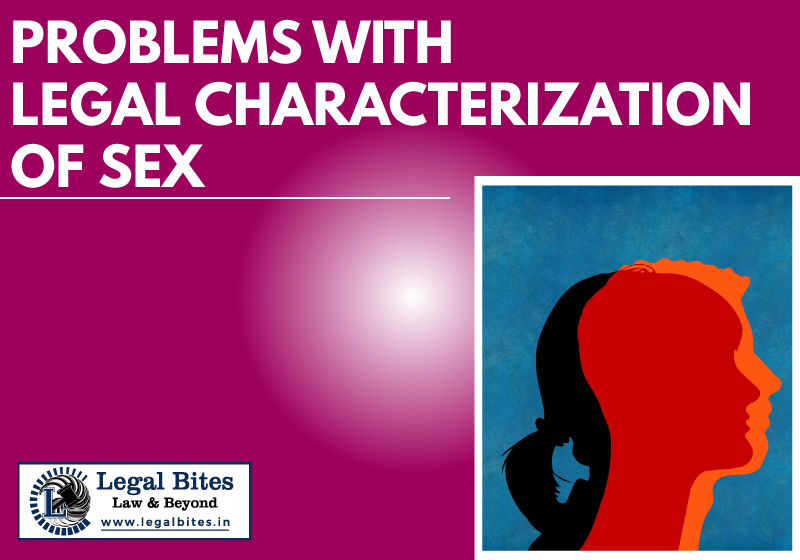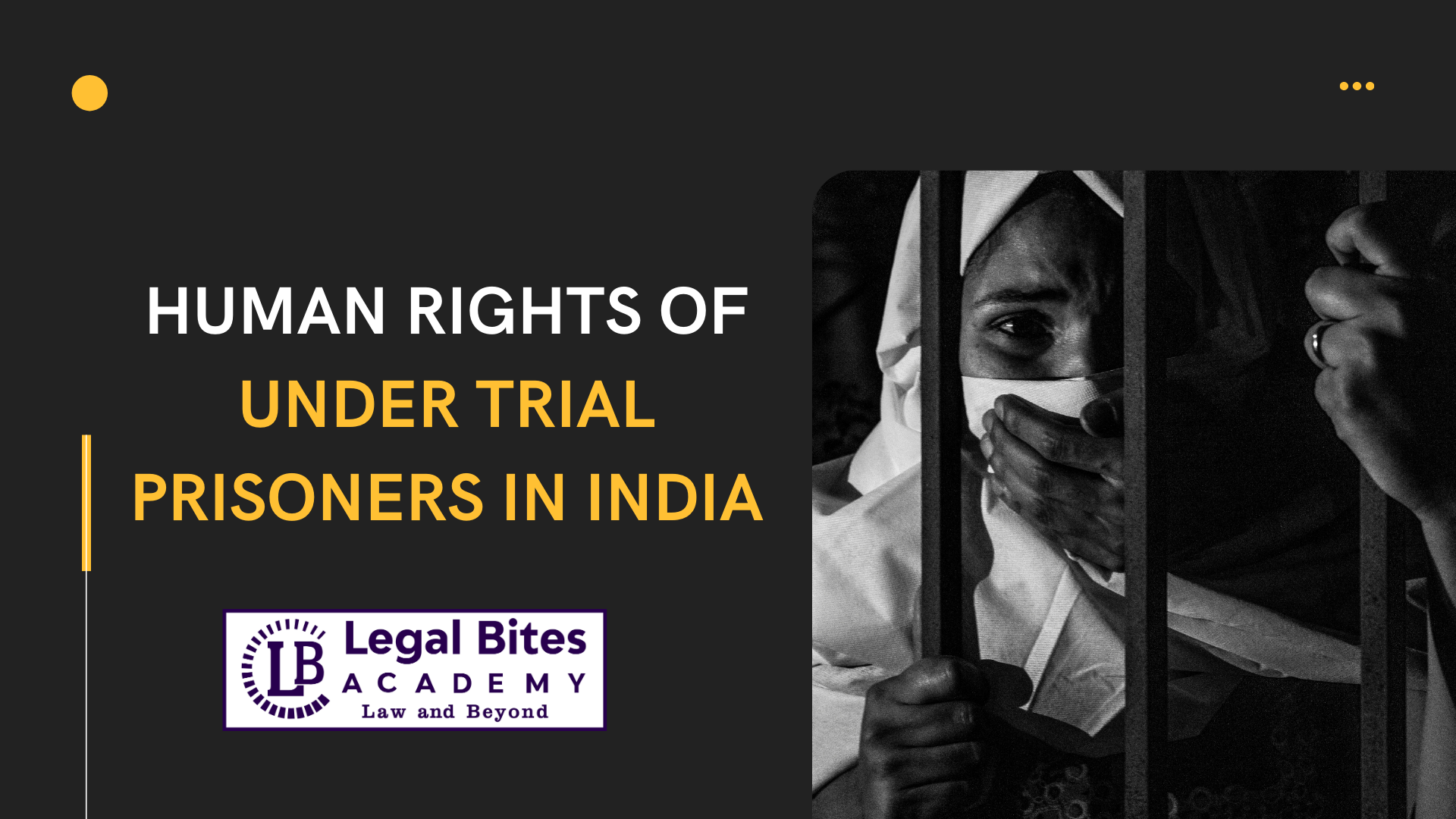The Problems With The Legal Characterization Of Sex: A Critique of the Transgender Persons (Protection of Rights) Act of 2019
The author of the article critiques the contentious Transgender Persons (Protection of Rights) Act, 2019, and its failure to usher in gender-inclusivity in India. I. Introduction “There is no one way to be transgender. . . there is no prototypical transgender experience. “[1] The most obvious way of physically demarcating between sex and gender is by understanding sex… Read More »
;
The author of the article critiques the contentious Transgender Persons (Protection of Rights) Act, 2019, and its failure to usher in gender-inclusivity in India. I. Introduction “There is no one way to be transgender. . . there is no prototypical transgender experience. “[1] The most obvious way of physically demarcating between sex and gender is by understanding sex as a set of physiological characters such as chromosomes, hormones, genitalia; and gender as a person’s...
The author of the article critiques the contentious Transgender Persons (Protection of Rights) Act, 2019, and its failure to usher in gender-inclusivity in India.
I. Introduction
“There is no one way to be transgender. . . there is no prototypical transgender experience. “[1]
The most obvious way of physically demarcating between sex and gender is by understanding sex as a set of physiological characters such as chromosomes, hormones, genitalia; and gender as a person’s inherent sense of self-identity.[2]
Gender non-conforming individuals have been subject to ignorance and resulting prejudice from society, including social welfare institutions; the most out and out affirmation of this point is how the Transgender Persons (Protection of Rights) Act 2019 was passed in the Lok Sabha without debate and the fact that the Act still sustains all the prejudices.
In India, the easiest and quick mental representation of people who are gender non-conforming or gender-expansive persons are the hijras. Hijras– whom some of us treat as possessing special powers of blessing couples with childbirth, some of us know them as people who beg on the roads, some of us know them as people who are intimidating, some of us know them to be involved in flesh trade. None of us have ever known them to be performing a nine-to-five desk job, none of us know them to be lawyers, judges, professors, scientists, engineers, or social workers, none of us know them to be political representatives or even government servants. This easy and formative idea of transgenders in India is in fact, very complex.
We always equate transgenders to hijras; and transgenders and hijras to intersexed persons, even though each of these designations is distinct from each other. What both identities do have in common, however, is that they’re both highly misunderstood and are identities that destabilize the deep-seated gender binary. The hijras, specifically, are perceived from the lens of the western understanding of gender and its constricting binary.
Neo-liberal globalization has not emancipated queer communities as economic proponents claim. Neo-liberal globalization focuses on the idea that development occurs on account of market participation by all individuals, and unfortunately, development strategies by financial institutions have largely been centered around heteronormative predispositions. The economic autonomy of men and women is emphasized in a nuclear and heterosexual family and that this is the ‘proper family’ where economic autonomy will make women equal inside in the family.
The economic activity and the communities they have under contemplation are only limited to the formal market sector and heterosexual nuclear families. However, much of the queer population lives outside the purview of ‘proper heterosexual’ families as much as they live outside the sphere of the formal market economy.
Structural adjustment programs[3] that are a direct by-product of neo-liberal globalization have resulted in a reduction in social spending on education, healthcare and social benefits. This has increased people’s dependence on extended families and friendship networks to sustain them in times of needs. Non-heterosexual and TGNC[4] folks are mostly excluded from formal employment and the existing family structure. Thus, these queer people center reliance on their own self-created and self-sustaining families and communities for protection against violence and for economic survival, which is fraught with patterns of subsistence, barter, collective and communal mutual aid.[5]
A mass chunk of the income that the Hijras and other South and Southeast Asian traditional transgender groups have gained has been in prostitution and in their traditional jobs of being entertainers in festivities. The more capitalist the economy grows, their roles are incorporated into the tourism and entertainment industries.
The growth of the sex trade has emerged as a concomitant of short term contractual employments, which have spurred the growth of an informal market economy. This along with the growth of international sex tourism has prompted the arrival of tourists from the Global North to Global South for cheap sex and immigrants to the global north from a significant number of sex workers. A reason for this has been the indiscriminate exclusion of TGNC folks from sectors of formal employment. However, the role of LGBT communities has been crucial in securing health care (AIDS activism has aimed to help all seropositive persons ) and employment rights (non-discrimination on grounds of sex and gender which includes women under its purview), that has been beneficial to cishet[6] people as well.
The Transgender Persons (Protection of Rights) Act (hereinafter referred to as “the Act”) has also focused on areas that are rudimentary to the Transgender and Gender Expansive Communities. This article explains how official public policy as manifest in the Act reinforces the legal characterization of sex, its harmful socio-legal effects and the resulting inevitable exclusion of transgender persons.
II. What Is the Legal Characterization of Sex?
Legal characterization of sex begins the moment a child takes birth- it starts from the birth certificate in which every infant is marked as male or female on the basis of their external genitalia. Additionally, the sex characterization on the birth certificate presumes that the child will grow up to be either boy or girl. For the rest of the person’s life, this “legal sex” will determine their relationship with the law and the bureaucracies where there are sex-specific legislations or sex-specific policies or sex-segregated spaces. Unfortunately, where does the transgender fit here?
Consider this perfectly encapsulated paragraph on how diverse gender identity can manifest itself in:
“…gender is each person’s deeply felt internal and individual experience of gender, which may or may not correspond with the sex assigned at birth, including the personal sense of the body (which may involve, if freely chosen, modification of bodily appearance or function by medical, surgical or other means) and other expressions of gender, including dress, speech, and mannerisms.”[7]
The legal characterization of sex is the process wherein, sex is designated as a legal fiction[8] to fit people into legal categories of “male” and “female”. Sex has always been attached to a morphology that emphasized its biological immutability, the way race was treated for a long time.
Now we know that sex is biological inasmuch as it is considered as parts of the body like the brain or heart. Interactions predisposed with assumptions about sex are nothing but social symbolic interactionism. Sure, we’ve got parts but why are these parts socially, culturally and legally important? Moreover, for legal sex particularly, its connotations vary depending on who registers the sex categorization- for social security schemes, at prisons, for passports, by the courts and other government agencies.
III. The Harmful Socio-Legal Consequences of Legally Characterizing Sex
Transgender persons experience violence, harassment and exclusion in sex-segregated contexts as a result of “mismatched identity documents and as a function of the inherent social control exercised by legal sex against those who are misclassified.”[9] In sex-segregated spaces such as prisons, shelter homes, drug treatment centers, psychiatric wards, and bathrooms, transgender people face the threat of violence while accessing these spaces.
The sex markers on the documents of transgenders contradict their expression of the identified gender and the sex marker outs them without their consent to authorities (police and law enforcement), who view these documents. Transgender interactions that are seemingly minutiae are oppressed with “humiliations, refusal to be served, possible harm from onlookers…”[10] This legal characterization is a means of exercising social control.
For individuals whose identities don’t fit the conventional Venn, the consequences of “reclassification” are frightening, especially where institutions prey on the poor and lower-caste persons, such as “criminal punishment systems, public benefits systems, and immigration systems. This misclassification intersects with and results in problems regarding housing, education, health care, identity documentation and records, employment,… public facilities,… police profiling, police brutality, and false arrest; sexual harassment and assault; beatings and rapes; evictions; denials and rejections from caseworkers in social service and welfare agencies; rejections for legal services; and family rejection.”[11]
So why then, do we insist on the legal sex while determining non-discrimination policies and access to public spaces, employment and marriage?
It is impossible to imagine transgenders as unvarying[12]– but that is exactly what legislative bodies and law enforcement agencies do. In the Act, the certification for transgender identity is contingent on what the District Magistrate makes of it, and if he is not convinced, then he may deny the certification; certification is contingent on the psychologist’s report, and contingent on the reports of a Chief Medical Officer if a person undergoes sex-change surgery after issuance of the certificate.[13] And yet, the Act claims the recognition of the right to self-perceived identity to the transgenders[14]-transgenders have only a modicum of control over their self-identity.
The District Magistrate’s denial of certification can be based on any indeterminate cause, one of which being, “you’re different from the imagination I had of a transgender” and the District Magistrate is required to verify the “correctness” of the psychologist’s report- on what grounds is he to verify the correctness of a psychologist’s report when he knows nothing about the transgender experience and definitely not as much as a psychologist knows.
The Transgender Persons Act basically creates multiple levels of authority all vested with the same purpose of deciding someone else’s gender identity. The Government may argue that the certification is necessary to confer socio-economic benefits on transgender persons, so as to prevent misuse and that is why the draft rules of the Act penalize any person who falsely claims the status of a transgender.[15] However, this certification is entirely unnecessary when the law eliminates the practice of legally characterizing sex.
If all establishments and offices are prohibited from discriminating on grounds of sex and gender in matters of employment and access to public spaces, then how should the certification matter at all?
IV. The Legal Characterization of Sex is Inherently Unequal:
Article 14 of the Indian Constitution contemplates equality, in that, persons placed similarly should be treated equally in terms of the rights and obligations imposed. The classification should not be merely on grounds of some qualities found in a class of persons to the exclusion of others. In fact, the accentuation of these characteristics as grounds for classification must be rational inasmuch as the classification conducts the realization of the objective of the legislation or enactment.
The “equal protection of laws” clause in Article 14 does not mean that all laws shall apply to all persons without discrimination although there might be differences in circumstances- this materializes that the laws shall apply without discrimination to persons similarly situated.
The above understanding of equality constructed the test of permissible classification in order to avoid mechanical equality when we know that all persons are not equal in their circumstances- different classes of persons are guided by their varying needs arising from the socio-political circumstances that create them- thus this rule of equality interprets equal treatment to all persons belonging to members of that class.
The legal characterization of sex is inequal inasmuch as it creates sex as a classification. The designations of sex as male and female become decisive in availing socio-economic benefits. For example, we know that the Domestic Violence Act is applicable to women alone; in all sexual offences the perceived victim is the woman alone; in the Hindu Succession Act, the devolution of succession differs depending on whether you are a woman or a man; Prevention of Sexual Harassment in Work Places– all these legislations categorize women as the victims. The justification underlying these legislations has been on grounds of the unequal negotiating powers that lace male-female interactions.
Authorities have been overlooking the fact that lawmakers have never made an effort to separate sex and gender by constantly using both terms interchangeably- a practice that has caused the exclusion of many genders. It is this ambiguity of unintelligibly entwining of sex and gender that is irrational. There are organizations fighting for men’s equality that are now trying to secure domestic violence reliefs just as women have now.
There is a stronger social construal attached to gender than there is to sex. While gender is fluid, sex is not. Sex is now being socialized and legalized because of how the law has never bothered to detangle sex and gender. And it is for this reason that the benefits of these legislations have been disproportionate to women spanning different socio-economic strata.
Domestic violence can happen to anyone, only, women and transgenders are under a greater risk, but should this fact unconditionally exclude men under its inclusion? The same can be said about inheritance and succession- by including men and women, they have excluded transgenders and gender non-conforming persons- this whole time, the man’s and the woman’s physiology was never a determinative, it was gender! Not sex! And when I say gender, I mean the lawmaker’s acknowledgment of the power dynamics.
The unequal power dynamics signify gender because although a male was born with a penis, the socialization around his male parts fostered his conception of the masculine. Any person with a penis doesn’t automatically make him an aggressive power-drunk individual. The socialization of sex is the manifestation of gender and not sex. Sex has been the uninvited guest disguised as gender in all these legislations. The objectives of these legislations are counter-productive inasmuch as they create reclassifications unnecessarily.
The Act essentially sustains the legal characterization of sex and thus, discriminates against transgender persons by treating them as an alien class of people to whom even ordinary laws against discrimination don’t apply. The chapter for offences and penalties in the Act, penalizes all kinds of abuse against a transgender, including sexual abuse, with imprisonment for six months which can extend to 2 years and a fine,[16] while under the IPC, the punishment for sexual offences is either life imprisonment or capital punishment. This is a blatant violation of Article 14 of the Constitution whereby, discrimination can only be allowed if there is any rational basis to the classification or an intelligible differentia.
The same offence of rape is being treated differently on account of who the victim is when the constituents of rape are the same and the effects of rape on a transgender person are just as damning as it is to anyone who gets raped. This is an example of how the legal characterization of sex can proliferate gender-induced discrimination and inequalities. Principally, the legal characterization of sex is inherently exclusionary and thus, an unequal process- when legal sex is prioritized over self-perceived gender.
Consider the case for gender-neutral public bathrooms. The most overpowering argument for restricting bathroom access to men and women alone (and thus making this about sex) has been something called “penis panics”[17]. It has been argued that a transwoman entering a woman’s toilet poses a threat to women’s privacy and sexual integrity but on the other hand, transmen (the perception has been that they are not considered as “real men” and are in essence females but they also don’t warrant protection because they’re men) are not seen to be of any threat. Thus here, the basis for fear has been the ‘penis’ or ‘male anatomies’.
The gendered idea of a sexual predator in our society is anyone with a penis, and transwomen with penises are perceived to pose that threat to women. This kind of characterization of sex stemming from the legal sex propagates a harmful gender order that:
- Women are inherently weak,
- Men are inherently rapists or paedophiles,
- There is a hierarchy of rights in which cisgender women warrant the greatest protection over transgender folks,
- Transgenders pose a potential threat to women, men and children.
Legal characterization reproduces harmful consequences by introducing the sex in places where sex is irrelevant or inconsequential and thereby, silencing the gender.
V. Conclusion
The law must eliminate sex as a categorization just as caste has been eliminated as categorization in public participation and access to public infrastructure. We must adopt gender mainstreaming in all our policies and laws. Every bill must stand the test of gender equality and not only from the lens of women alone but also include TGNC persons under our contemplation as law and public policymakers.
The Transgender Persons (Protection of Rights) Act must recognize socially and culturally important gender-expansive communities such as the hijras as part of SEBCs and extend reservations to them. If certification is not eliminated, then at the least, its assignment should be with the National Commission for Transgender Persons.
The provisions for health care as provided in the Act are broad and not specific and there is no provision to mandate all hospitals to create gender-inclusive environments such as staff being trained to inquire about a person’s preferred pronouns and having gender-neutral bathrooms. The Act must make provisions for altering public infrastructure in government spaces to establish transgender-friendly spaces and construct gender-neutral bathrooms.[18]
References
- Transgender Persons (Protection of Rights) Act, No. 40 of 2019.
- Kristen Schilt and Laurel Westbrook, Bathroom Battlegrounds and Penis Panics, 14(3), SAGE Publications 26,31 (2005).
- Olga Tomchin, Bodies and Bureaucracy: Legal Sex Classification and Marriage-Based Immigration for Trans People, 101(3), CALI. LAW REV.813,819 (2013).
- Kearns, Laura-Lee, Transphobia and Cisgender Privilege: Pre-Service Teachers Recognizing and Challenging Gender Rigidity in Schools, 40(1) Canadian Journal of Education 1,27 (2017).
- Faucette & Avory, CHAPTER FOUR: Fucking the Binary for Social Change: Our Radically Queer Agenda, 437, Counterpoints 73, 88 (2014).
- Davis, Alexander, The Hidden Privilege in ‘Potty Politics’, 16(3) Contexts 34, 41 (2017).
- Gonzales, Gibert & Carrie Henning Smith, Barriers to Care Among Transgender and Gender Nonconforming Adults, 95(4) The Milbank Quarterly 726, 748 (2017).
- Miller, Lisa & Eric Anthony Grollman, The Social Costs of Gender Nonconformity for Transgender Adults: Implications for Discrimination and Health, 30(3), Sociological Forum 809, 831 (2015).
- Trisha Mukherjee, Equality for Transgenders, 48(49), EPW 1, 4 (2013).
- Sujata Moorti, A Queer Romance with the Hijra, 3(2), QED: A Journal in GLBTQ Worldmaking 18, 34 (2016).
- Peter Drucker, Changing Families and Communities: An LGBT Contribution to an Alternative Development Path, 19(7), Development in Practice 825, 836 (2009).
[1]Dylan Vade, Expanding Gender and Expanding the Law: Toward a Social and Legal Conceptualkation of Gender That Is More Inclusive of Transgender People, 11 MICH. J. GENDER & L. 253,271 (2005).
[2]Melinda Mangin, Supporting Transgender and Gender Expansive Children in School, 100(2), PDK 16, 17 (2018):
“Sex is often thought of as a binary: male or female. However…of people are intersex, meaning that their physical bodies do not conform to standard definitions of male and female. Despite these variations, sex is regularly assigned at birth based on the appearance of external genitalia… It is generally assumed that male and female babies will develop gender identities as boys and girls, respectively. People whose gender identity matches their sex assigned at birth are known as cisgender, while people whose gender identity does not match their sex assigned at birth are known as transgender…The term gender-expansive is increasingly being used for people who challenge cultural expectations regarding gender roles, identities, expressions or norms. Gender-expansive individuals may further describe themselves as non-binary, gender fluid, or genderqueer.”
[3] Structural adjustment programs (SAPs) consist of loans (structural adjustment loans; SALs) provided by the International Monetary Fund (IMF) and the World Bank (WB) to countries that experienced economic crises.
[4] Transgender and Gender Non-Conforming.
[5] Peter Drucker, Changing Families and Communities: An LGBT Contribution to an Alternative Development Path, 19(7), Development in Practice 825, 836 (2009).
[6] Cisgender and Heterosexual identities.
[7] Olga Tomchin, Bodies and Bureaucracy: Legal Sex Classification and Marriage-Based Immigration for Trans People, 101(3), CALI. LAW REV.813,819 (2013).
[8] The designation of sex on birth certificates is a legal fiction because the sex here is assumed. The experiences of gender identity are so diverse that some gender non-conforming persons seek to undergo gender-confirming health care that can alter sex. Unfortunately, this alteration doesn’t go on the birth certificate and what stays on the certificate is only a legal presumption for the purposes of determining future sex-specific legal consequences.
[9] Olga Tomchin, supra note 7 at 813.
[10] Olga Tomchin, supra note 10 at 825.
[11] Olga Tomchin, supra note 11.
[12] The transgender experience is in itself a multicultural esplanade. Transgenders may be straight, lesbian or gay, bisexual, pansexual, asexual. Some transgenders might have cisgender partners and some have transgender partners. Some transgenders may identify with either of binary identities, some may identify as neither of the binary identities, some transgenders have non-binary identities. For some transgenders, the experience with gender shows early in childhood and remains consistent and some transgenders have fluid identities that may change and evolve with time. Besides, sex reassignment surgeries are not imbibed with the powers to magically change the sex overnight. Some transgenders experience psychological trauma resulting from the discontent and confusion they feel over their bodies not aligned to their understanding of their gender identity and seek out gender-affirming medical care to overcome dysphoria for which they may undergo a number of treatments that may include hormone therapies, hair removal, etc. Other transgenders who don’t experience dysphoria don’t undergo surgeries. All transgenders are just as valid. However, intersecting inequalities prevent many transgenders from availing health care arising from discrimination spanning across not gender alone but caste, race, ethnicity, class, and religion.
[13] Transgender Persons (Protection of Rights) Act, No. 40 of 2019, Section 6 and 7.
[14] Transgender Persons (Protection of Rights) Act, No. 40 of 2019, Section 4.
[15] Transgender Persons (Protection of Rights) Draft Rules, Rule 12. “Penalty: In case an applicant makes an application under rule 3 with an intention falsely to obtain the status of a transgender person such an applicant shall be liable for prosecution under penal laws of the country.”
[16] Transgender Persons (Protection of Rights) Act, No. 40 of 2019, Section 18(d).
[17]Kristen Schilt and Laurel Westbrook, Bathroom Battlegrounds and Penis Panics, 14(3), SAGE Publications 26,30 (2005).
[18]Gender-neutral bathrooms save space and can be used as family toilets, and will be thus, equally beneficial to cishet folks. To tackle penis panics, gender-neutral toilets can be constructed with private toilet cubicles for males and females and designate security guards at every toilet to ensure the safety of all persons who use these public toilets. The compulsory designation of security guards at public toilets will generate employment as well.





